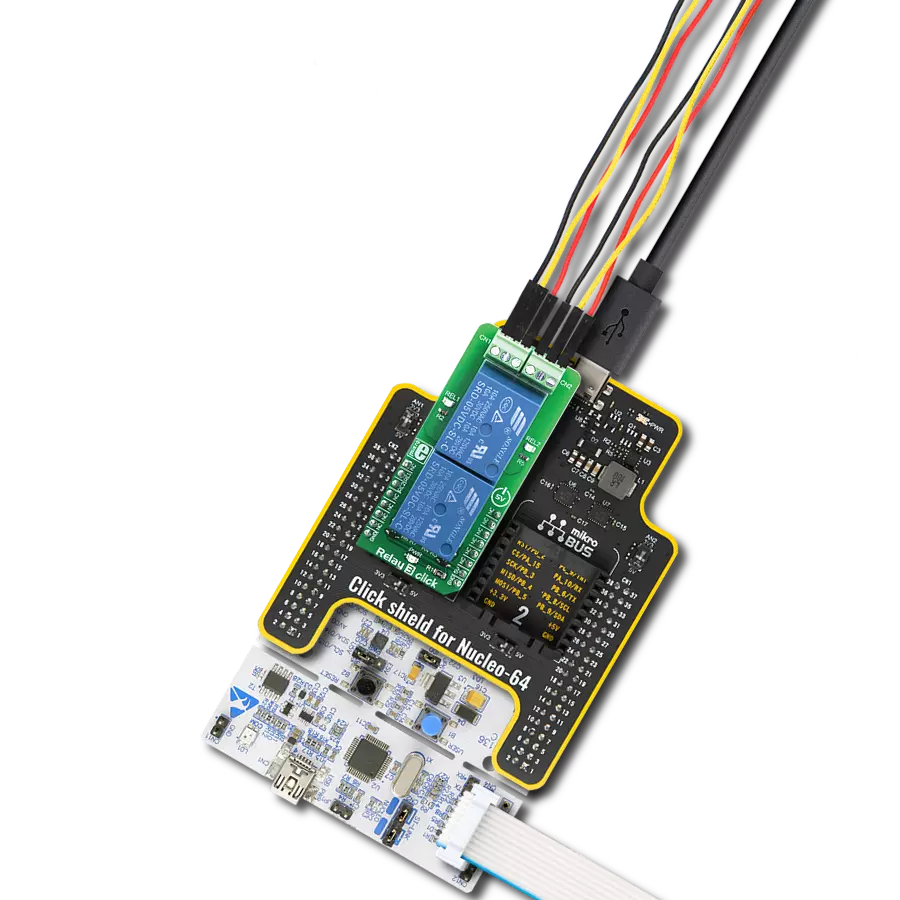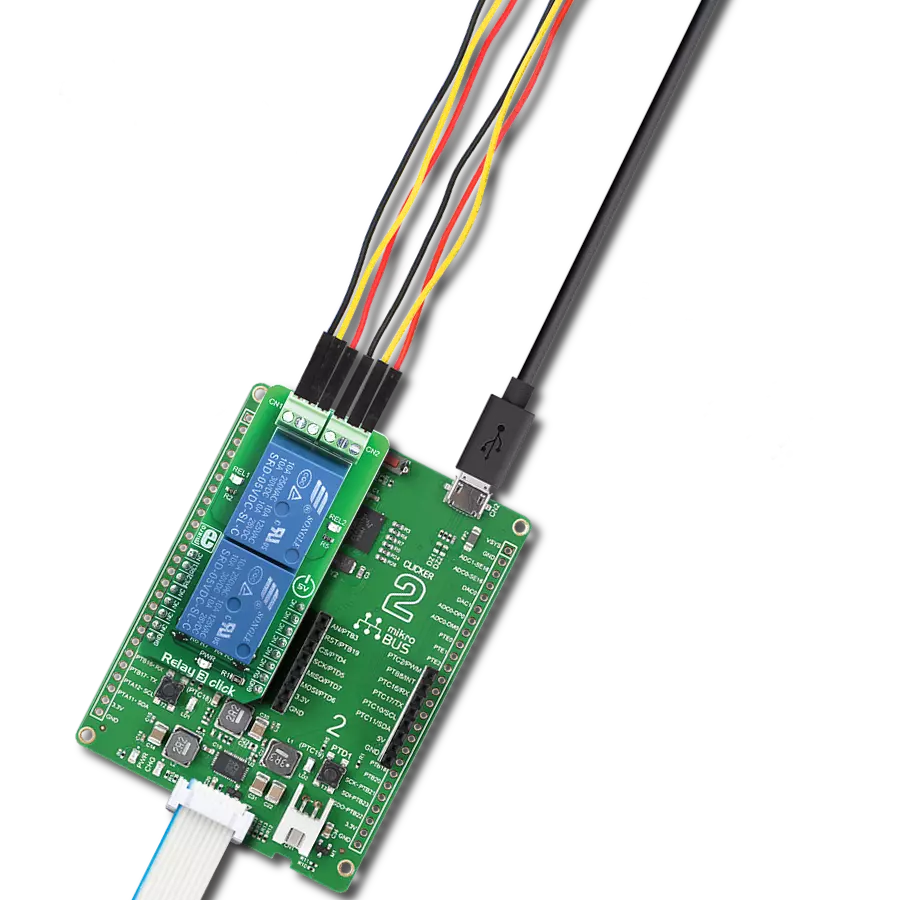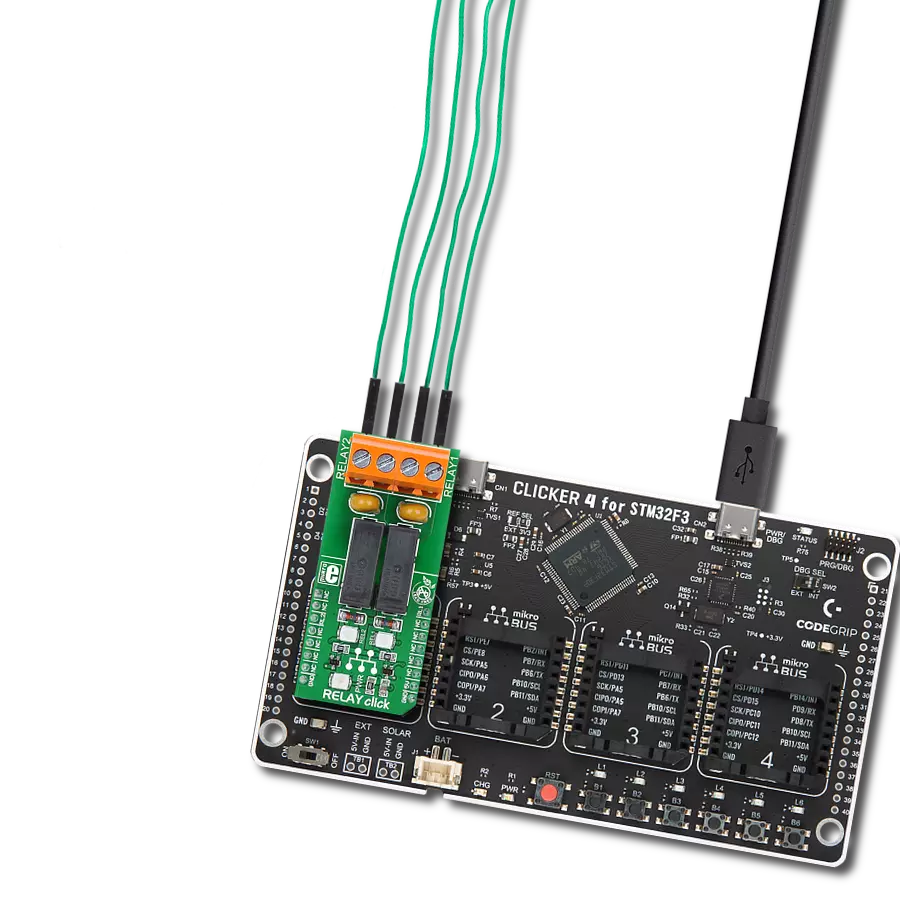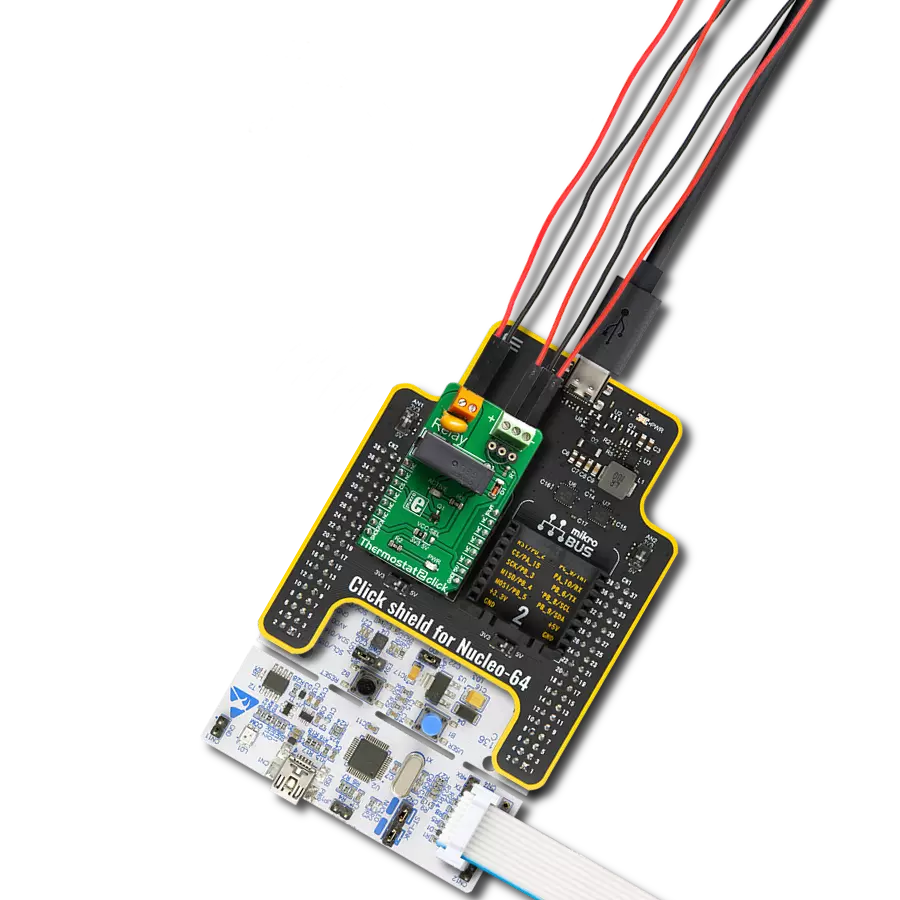From industrial automation to home automation, our SSRs offer the precision and safety you need to stay ahead of the curve
A
A
Hardware Overview
How does it work?
SolidSwitch 3 Click is based on the BD8LB600FS-C, an automotive eight-channel low-side load switch from Rohm Semiconductor. Every switch is controlled through a serial peripheral interface and includes an N-channel MOSFET that supports a maximum current of 1A. The BD8LB600FS-C offers flexible protection boundaries for systems against input voltage up to 5V and limits the output load current, making this device ideal for driving resistive, inductive, and capacitive loads. This Click board™ communicates with MCU through a standard SPI interface and operates at clock rates up to 5MHz, providing data in a digital format of 16 bits. It also has the Reset feature labeled as RST and routed to the RST pin of the
mikroBUS™ socket. In addition to these pins, there are a few more, like DIR and two input pins, IN1 and IN2 pins, routed to the AN, PWM, and INT pins of the mikroBUS™ socket. The DIR signal represents a transition to a direct mode activated by setting this pin to a high logic level. Depending on the set logic state on the DIR pin, pins IN1 and IN2 can be used to control the given output channels; IN1 represents the control of channels 1 and 5 when the DIR is at a low logic state, while IN2 defines the management of channels 2 and 6 when the DIR is at a low logic state. When the DIR is set to a high logic state, IN1 controls only channel 5 and IN2 only channel 6. As mentioned, the BD8LB600FS-C also has built-in protection
circuits, namely the overcurrent, the thermal shutdown, the open-load detection, and the voltage lock-out circuits. Moreover, this device also possesses a diagnostic output function during abnormal detection. This Click board™ can operate with either 3.3V or 5V logic voltage levels selected via the VCC SEL jumper. This way, both 3.3V and 5V capable MCUs can use the communication lines properly. Also, this Click board™ comes equipped with a library containing easy-to-use functions and an example code that can be used as a reference for further development.
Features overview
Development board
Arduino UNO is a versatile microcontroller board built around the ATmega328P chip. It offers extensive connectivity options for various projects, featuring 14 digital input/output pins, six of which are PWM-capable, along with six analog inputs. Its core components include a 16MHz ceramic resonator, a USB connection, a power jack, an
ICSP header, and a reset button, providing everything necessary to power and program the board. The Uno is ready to go, whether connected to a computer via USB or powered by an AC-to-DC adapter or battery. As the first USB Arduino board, it serves as the benchmark for the Arduino platform, with "Uno" symbolizing its status as the
first in a series. This name choice, meaning "one" in Italian, commemorates the launch of Arduino Software (IDE) 1.0. Initially introduced alongside version 1.0 of the Arduino Software (IDE), the Uno has since become the foundational model for subsequent Arduino releases, embodying the platform's evolution.
Microcontroller Overview
MCU Card / MCU

Architecture
AVR
MCU Memory (KB)
32
Silicon Vendor
Microchip
Pin count
28
RAM (Bytes)
2048
You complete me!
Accessories
Click Shield for Arduino UNO has two proprietary mikroBUS™ sockets, allowing all the Click board™ devices to be interfaced with the Arduino UNO board without effort. The Arduino Uno, a microcontroller board based on the ATmega328P, provides an affordable and flexible way for users to try out new concepts and build prototypes with the ATmega328P microcontroller from various combinations of performance, power consumption, and features. The Arduino Uno has 14 digital input/output pins (of which six can be used as PWM outputs), six analog inputs, a 16 MHz ceramic resonator (CSTCE16M0V53-R0), a USB connection, a power jack, an ICSP header, and reset button. Most of the ATmega328P microcontroller pins are brought to the IO pins on the left and right edge of the board, which are then connected to two existing mikroBUS™ sockets. This Click Shield also has several switches that perform functions such as selecting the logic levels of analog signals on mikroBUS™ sockets and selecting logic voltage levels of the mikroBUS™ sockets themselves. Besides, the user is offered the possibility of using any Click board™ with the help of existing bidirectional level-shifting voltage translators, regardless of whether the Click board™ operates at a 3.3V or 5V logic voltage level. Once you connect the Arduino UNO board with our Click Shield for Arduino UNO, you can access hundreds of Click boards™, working with 3.3V or 5V logic voltage levels.
Used MCU Pins
mikroBUS™ mapper
Take a closer look
Click board™ Schematic

Step by step
Project assembly
Software Support
Library Description
This library contains API for SolidSwitch 3 Click driver.
Key functions:
solidswitch3_enable_output- This function enables the specified output channel.solidswitch3_disable_output- This function disables the specified output channel.solidswitch3_reset- This function resets the device by toggling the reset pin.
Open Source
Code example
The complete application code and a ready-to-use project are available through the NECTO Studio Package Manager for direct installation in the NECTO Studio. The application code can also be found on the MIKROE GitHub account.
/*!
* @file main.c
* @brief SolidSwitch3 Click example
*
* # Description
* This example demonstrates the use of SolidSwitch 3 Click board by controlling
* the output state.
*
* The demo application is composed of two sections :
*
* ## Application Init
* Initializes the driver and performs the Click default configuration.
*
* ## Application Task
* Enables all outputs one by one in the span of 8 seconds, and after that disables
* all outputs for 3 seconds. Accordingly, the outputs status will be displayed on the USB UART.
*
* @author Stefan Filipovic
*
*/
#include "board.h"
#include "log.h"
#include "solidswitch3.h"
static solidswitch3_t solidswitch3;
static log_t logger;
/**
* @brief SolidSwitch 3 display all enabled channels function.
* @details This function displays all enabled channels on USB UART.
* @param[out] ctx : Click context object.
* See #solidswitch3_t object definition for detailed explanation.
* @return None.
* @note None.
*/
static void solidswitch3_display_enabled_channels ( solidswitch3_t *ctx );
void application_init ( void )
{
log_cfg_t log_cfg; /**< Logger config object. */
solidswitch3_cfg_t solidswitch3_cfg; /**< Click config object. */
/**
* Logger initialization.
* Default baud rate: 115200
* Default log level: LOG_LEVEL_DEBUG
* @note If USB_UART_RX and USB_UART_TX
* are defined as HAL_PIN_NC, you will
* need to define them manually for log to work.
* See @b LOG_MAP_USB_UART macro definition for detailed explanation.
*/
LOG_MAP_USB_UART( log_cfg );
log_init( &logger, &log_cfg );
log_info( &logger, " Application Init " );
// Click initialization.
solidswitch3_cfg_setup( &solidswitch3_cfg );
SOLIDSWITCH3_MAP_MIKROBUS( solidswitch3_cfg, MIKROBUS_1 );
if ( SPI_MASTER_ERROR == solidswitch3_init( &solidswitch3, &solidswitch3_cfg ) )
{
log_error( &logger, " Communication init." );
for ( ; ; );
}
SET_SPI_DATA_SAMPLE_EDGE;
if ( SOLIDSWITCH3_ERROR == solidswitch3_default_cfg ( &solidswitch3 ) )
{
log_error( &logger, " Default configuration." );
for ( ; ; );
}
log_info( &logger, " Application Task " );
}
void application_task ( void )
{
for ( uint16_t cnt = SOLIDSWITCH3_CH_OUT1; cnt <= SOLIDSWITCH3_CH_OUT8; cnt <<= 1 )
{
if ( SOLIDSWITCH3_OK == solidswitch3_enable_output ( &solidswitch3, cnt ) )
{
solidswitch3_display_enabled_channels( &solidswitch3 );
Delay_ms ( 1000 );
}
}
if ( SOLIDSWITCH3_OK == solidswitch3_disable_output ( &solidswitch3, SOLIDSWITCH3_ALL_CHANNELS ) )
{
solidswitch3_display_enabled_channels( &solidswitch3 );
Delay_ms ( 1000 );
Delay_ms ( 1000 );
Delay_ms ( 1000 );
}
}
int main ( void )
{
/* Do not remove this line or clock might not be set correctly. */
#ifdef PREINIT_SUPPORTED
preinit();
#endif
application_init( );
for ( ; ; )
{
application_task( );
}
return 0;
}
static void solidswitch3_display_enabled_channels ( solidswitch3_t *ctx )
{
uint16_t output_state = ctx->output_state;
uint8_t enabled_flag = 0;
log_printf( &logger, " Outputs enabled: " );
for ( uint8_t cnt = 1; cnt <= 16; cnt++ )
{
if ( SOLIDSWITCH3_OUT_ENABLE == ( output_state & SOLIDSWITCH3_OUT_BITS_MASK ) )
{
if ( enabled_flag == 1 )
{
log_printf( &logger, ", %u", ( uint16_t ) cnt );
}
else
{
log_printf( &logger, " %u", ( uint16_t ) cnt );
}
enabled_flag = 1;
}
output_state >>= 2;
}
if ( enabled_flag == 0 )
{
log_printf( &logger, " none" );
}
log_printf( &logger, "\r\n-----------------------\r\n" );
}
// ------------------------------------------------------------------------ END
Additional Support
Resources
Category:Relay




































